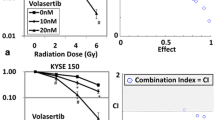Abstract
The monoclonal antibody (MoAb) KIS1 has been shown to react specifically with an antigen of human squamous cell carcinoma (SCC); however, a major problem in its clinical application is that the intact murine antibody induces a human anti-mouse antibody (HAMA). To overcome this problem, we produced the KIS1 F(ab')2 fragment, then radioiodinated the intact KIS1 antibody and its F(ab')2 fragment. Nude mice bearing human esophageal SCC implants were injected with 100μCi of131I-intact, KIS1 or131I-KIS1 F(ab')2, and images were obtained using a gamma camera. Radioimmunotherapy (RIT) was performed by injecting the tumor-bearing nude mice with131I-intact KIS1 or131I-KIS1 F(ab')2 at a dosage of 300μCi, following which 7 or 3 days were required to produce high quality tumor images by scintigraphy. The tumor-bearing mice treated with131I-KIS1 F(ab')2 showed significant tumor growth inhibition, about 5.4 times greater than that of the control group and 1.8 times greater than that of the131I-intact KIS1 group 21 days after the injection. These results indicate that the KIS1 F(ab')2 fragment is superior to intact KIS1, and that it may be clinically useful for radioimmunodetection followed by tumor targeting therapy for patients with SCC of the esophagus.
Similar content being viewed by others
References
Kato H, Watanabe H, Tachimori Y, Iizuka T (1991) Evaluation of neck lymph node dissection for thoracic esophageal carcinoma. Ann Thorac Surg 51:931–935.
Colapinto EV, Humphrey PA, Zalutsky MR, Groothuis DR, Friedman HS, Tribolet N, Carrel S, Bigner DD (1988) Comparative localization of murine monoclonal antibody Mel-14 F(ab')2 fragment and whole IgG2a in human glioma xenografts. Cancer Res 48:5701–5707
Wessels BW (1990) Current status of animal radioimmunotherapy. Cancer Res 50:970s-973s
Blumenthal RD, Sharkey RM, Synder D, Goldenberg DM (1989) Reduction by anti-antibody administration of the radiotoxicity associated with131I-labeled antibody to carcinoembryonal antigen in cancer radiommunotherapy. J Natl Cancer Inst 81:194–199
Sharkey RM, Blumenthal RD, Hansen HJ, Goldenberg DM (1990) Biological considerations for radioimmunotherapy. Cancer Res 50:964s-969s
Naito M, Imamura M, Kannagi R, Tobe T (1990) Production of monoclonal antibody to human esophageal cancer cell line. Jpn J Surg 20:170–179
Köhler G, Milstein C (1975) Continuous cultures of fused cells secreting antibody of predefined specificity. Nature 256:495–497
Goldenberg DM (1993) Monoclonal antibodies in cancer detection and therapy. Am J Med 94:297–312
Courtenay-Luck NS, Epenetos AA, Moore R, Larche M, Pectasiders D, Dhokia B, Ritter MA (1986) Development of primary and secondary immune responses to mouse monoclonal antibodies used in the diagnosis and therapy of malignant neoplasms. Cancer Res 46:6489–6493
Schroff RW, Foon KA, Beatty SM, Oldham RK, Morgan Jr AC (1985) Human anti-murine immunoglobin responses in patients receiving monoclonal antibody therapy. Cancer Res 45:879–85
Miller RA, Oseroff AR, Stratte PT, Levy R (1983) Monoclonal antibody therapeutic trials in seven patients with T-cell lymphoma. Blood 62:988–995
Colcher D, Zalutsky M, Kaplan W, Kute D, Austin F, Schlom J (1983) Radiolocalization of human mammary tumors in athymic mice by a monoclonal antibody. Cancer Res 43:736–742
Gerretsen M, Quak JJ, Suh JS, van Walsum M, Meijer CJLM, Snow GB, Dongen GAMS (1991) Superior localisation and imaging of radiolabelled monoclonal antibody E48 F(ab')2 fragment in xenografts of human squamous cell carcinoma of the head and neck and of the vulva as compared to monoclonal antibody E48 IgG. Br J Cancer 63:37–44
Endo K, Kamma H, Ogata T (1988) Radiolabeled monoclonal antibody 15 and its fragments for localization and imaging of xenografts of human lung cancer. J Natl Cancer Inst 80:835–842
Covell DG, Barbet J, Holton OD (1986) Pharmacokinetics of monoclonal immunogloblin G1, F(ab')2, and Fab' in mice. Cancer Res 46:3969–3978
Wahl RL, Parker CW, Philpott GW (1983) Improved radioimaging and tumor localization with monoclonal F(ab')2. J Nucl Med 24:316–325
Tuda T, Koshiba H, Usui T, Kubota M, Kikuchi K, Morita K (1990) Radioimmunoscintigraphy of human pancreatic carcinoma xenografts in nude mice with131I-labeled monoclonal antibody. Ann Nucl Med 4:71–74
Goodwin DA (1987) Pharmacokinetics and antibodies. J Nucl Med 28:1358–1362
Endo K, Kamma H, Ogata T (1987) Radiolocalization of xenografted human lung cancer with monoclonal antibody 8 in nude mice. Cancer Res 47:5427–5432
Stein R, Blumenthal R, Sharkey RM, Goldenberg DM (1994) Comparative biodistribution and radioimmunotherapy of monoclonal antibody RS7 and its F(ab')2 in nude mice bearing human tumor xenografts. Cancer (Supplement) 73:816–823
Pedley RB, Boden JA, Boden R, Dale R, Begent RHJ (1993) Comparative radioimmunotherapy using intact or F(ab')2 fragments of131I anti-CEA antibody in a colonic xenograft model. Br J Cancer 68:69–73
Miller RA, Maloney DG, McKillop J, Levy R (1981) In vivo effects of murine hybridoma monoclonal antibody in a patient with T-cell leukemia. Blood 58:78–86
Weiden PL, Wolf SB, Breitz HB, Applelbaum JW, Seiler CA, Mallett R, Bjorn MJ, Fu-Min S, Fer MF, Salk D (1994) Human anti-mouse antibody supression with cyclosporin A., Cancer (Supplement) 73:1093–1097
Sharkey RM, Motta-Hennessy C, Pawlyk D, Siegel JA, Goldenberg DM (1990) Biodistribution and radiation dose estimate for yttrium- and iodine-labeled monoclonal antibody IgG and fragments in nude mice bearing human colonic tumor xenografts. Cancer Res 50:2330–2336
Hosono MN, Hosono M, Endo K, Ueda R, Onoyama Y (1994) Effect of hyperthermia on tumor uptake of radiolabeled antineural cell adhesion molecule antibody in small-cell lung cancer xenografts. J Nucl Med 35:504–509
Pedley RB, Begent RHJ, Boden JA, Boxer GM, Boden R, Keep PA (1994) Enhancement of radioimmunotherapy by drugs modifying tumour blood flow in a colonic xenograft model. Int J Cancer 57:830–835
Author information
Authors and Affiliations
Rights and permissions
About this article
Cite this article
Fujii, T., Yamana, H., Toh, Y. et al. The effect of radioimmunotherapy using murine monoclonal antibody KIS1 on esophageal squamous cell carcinoma-bearing nude mice. Surg Today 27, 1026–1034 (1997). https://doi.org/10.1007/BF02385783
Received:
Accepted:
Issue Date:
DOI: https://doi.org/10.1007/BF02385783




